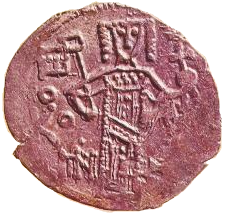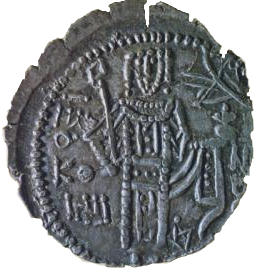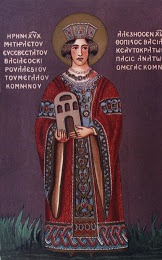Related Research Articles
Michael Panaretos was an official of the Trapezuntine empire and a Greek historian. His sole surviving work is a chronicle of the Trapezuntine empire of Alexios I Komnenos and his successors. This chronicle not only provides a chronological framework for this medieval empire, it also contains much valuable material on the early history of the Ottoman Turks from a Byzantine perspective, however it was almost unknown until Jakob Philipp Fallmerayer discovered it in the nineteenth century among the manuscripts of the Biblioteca Marciana of Venice. "Owing to this drab but truthful chronicle," writes the Russian Byzantist Alexander Alexandrovich Vasiliev, "it has become possible to a certain extent to restore the chronological sequence of the most important events in the history of Trebizond. This Chronicle covers the period from 1204 to 1426 and gives several names of emperors formerly unknown."
Alexios I Megas Komnenos or Alexius I Megas Comnenus was, with his brother David, the founder of the Empire of Trebizond and its ruler from 1204 until his death in 1222. The two brothers were the only male descendants of the Byzantine Emperor Andronikos I, who had been dethroned and killed in 1185, and thus claimed to represent the legitimate government of the Empire following the conquest of Constantinople by the Fourth Crusade in 1204. Although his rivals governing the Nicaean Empire succeeded in becoming the de facto successors, and rendered his dynastic claims to the imperial throne moot, Alexios' descendants continued to emphasize both their heritage and connection to the Komnenian dynasty by referring to themselves as Megas Komnenos or Grand Komnenos.

John II Megas Komnenos was Emperor of Trebizond from 1280 to 1297. He was the youngest son of Emperor Manuel I and his third wife, Irene Syrikaina, a Trapezuntine noblewoman. John succeeded to the throne after his full-brother George was betrayed by his archons on the mountain of Taurezion. It was during his reign that the style of the rulers of Trebizond changed; until then, they claimed the traditional title of the Byzantine emperors, "Emperor and Autocrat of the Romans", but from John II on they changed it to "Emperor and Autocrat of all the East, the Iberians, and the Transmarine Provinces", although Iberia had been lost in the reign of Andronikos I Gidos.
Saint Eugenios or Eugene was martyred under Diocletian and a cult devoted to him developed in Trebizond. His feast day is 21 January. Eugenios along with the martyrs Candidus, Valerian and Aquila was persecuted during the reign of Diocletian (284-305) and Maximian (305-311). The four hid in the mountains above Trebizond, but were eventually found and brought before the regimental commander Lycius. They were flogged, tortured with fire and eventually beheaded. Eugenios is credited with the destruction of the image on the "gray hill" overlooking the city, later known as the Mithratis.

Alexios II Megas Komnenos, was Emperor of Trebizond from 1297 to 1330. He was the elder son of John II and Eudokia Palaiologina.

Alexios III Megas Komnenos, or Alexius III, was Emperor of Trebizond from December 1349 until his death. He is perhaps the best-documented ruler of that country, and his reign is distinguished by a number of religious grants and literary creations.
Manuel II Megas Komnenos was Emperor of Trebizond for eight months in 1332. He was the only child known to hold the office of Emperor of Trebizond. Manuel was the son of Emperor Andronikos III, whom he succeeded at the age of eight in January 1332.

Irene Palaiologina, was Empress of Trebizond from April 6, 1340 to July 17, 1341. She was an illegitimate daughter of the Byzantine Emperor Andronikos III Palaiologos, and she married Emperor Basil of Trebizond in 1335.

Michael Megas Komnenos was Emperor of Trebizond for one day, July 30, 1341, and from May 3, 1344 to December 13, 1349. He was a younger son of Emperor John II of Trebizond and Eudokia Palaiologina.
David Komnenos was one of the founders of the Empire of Trebizond and its joint ruler together with his brother Alexios until his death. At least two lead seals and an inscription found on a tower in Heraclea Pontica attest that he was the first of his family to use the style Megas Komnenos. Ηe was the son of Manuel Komnenos and grandson of the Emperor Andronikos I.

Irene of Trebizond was an Empress consort of Trebizond as the bigamous wife of Basil of Trebizond. She had an important position in the regency of her son Alexios III of Trebizond in 1341-1352.

Theodora Komnene Kantakouzene was the Empress consort of Alexios III of Trebizond.
Gulkhan-Eudokia was the first Empress consort of Manuel III of Trebizond. Her original name was Gulkhan Khatun; Eudokia was her Christian baptismal name.
Anna Philanthropene was the second Empress consort of Manuel III of Trebizond.
Niketas Scholares, was a Byzantine Greek aristocrat and one of the leading officials of the Empire of Trebizond, eventually becoming megas doux. Niketas was a leader of the Scholarioi faction in Trebizond during the civil wars of the mid-14th century.
Anna Megale Komnene, was a Trapezuntine Queen consort of Georgia as the second wife of King Bagrat V. She was the mother of his youngest son, Constantine I of Georgia, who would later in 1407 succeed his half-brother, King George VII and reign as king.
Eudokia Megale Komnene, was a Trapezuntine noblewoman and a member of the powerful Byzantine Komnenos dynasty as a daughter of Emperor Alexios III of Trebizond.

The New Juma Mosque is a mosque in Trabzon, Turkey. It was built during Byzantine times as the Hagios Eugenios Church, dedicated to Saint Eugenius, the patron saint of the city. Following the capture of the city by Sultan Mehmed the Conqueror in 1461, like many churches in that city it was converted to a mosque.
The siege of Trebizond in 1222–1223 was an unsuccessful siege of Trebizond, the capital of the namesake empire, by the Seljuq Turks under a certain Melik. According to the late 14th-century Synopsis of Saint Eugenius of John Lazaropoulos, the city was close to being captured, but was saved by an unusually severe storm. The Seljuq assaults were repulsed, and their army was annihilated on its retreat through the attacks of the Matzoukaites, fierce mountain tribes under Trebizond's rule, and Melik was captured.
Limnia was the westernmost subdivision of the medieval Empire of Trebizond, consisting of the southern coastline of the Black Sea around the mouth of the Yeşilırmak River.
References
- ↑ Jan Olof Rosenqvist's date. Rosenqvist, The Hagiographic Dossier of St. Eugenios of Trebizond in Codex Athous Dionysiou 154 (Uppsala: Acta Universitatis, 1996), p. 30
- ↑ Lazaropoulos, Synopsis, ll. 1626-1629; translated in Rosenqvist, Hagiographic Dossier, p. 337
- ↑ Rosenqvist, Hagiographic Dossier, pp. 457, commentary on line 1610.
- ↑ Lazaropoulos, Synopsis, ll. 1664-1672; translated in Rosenqvist, Hagiographic Dossier, p. 339
- ↑ Lazaropoulos, Synopsis, ll. 1673-1664; translated in Rosenqvist, Hagiographic Dossier, p. 339
- ↑ Lazaropoulos, Synopsis, ll. 1690f; translated in Rosenqvist, Hagiographic Dossier, p. 341
- ↑ Lazaropoulos, Synopsis, ll. 1699ff; translated in Rosenqvist, Hagiographic Dossier, p. 341
- ↑ Panaretos, Chronicle, 15. Greek text in Original-Fragmente, Chroniken, Inschiften und anderes Materiale zur Geschichte des Kaiserthums Trapezunt, part 2; in Abhandlungen der historischen Classe der königlich bayerischen Akademie 4 (1844), abth. 1, p. 23; German translation, p. 52
- ↑ Panaretos, Chronicle, 34. Greek text in Original-Fragmente, p. 34; German translation, p. 59
- ↑ Panaretos, Chronicle, 40. Greek text in Original-Fragmente, p. 31; German translation, pp. 61f, English translation in Anthony Bryer, "Greeks and Türkmens: The Pontic Exception", Dumbarton Oaks Papers, 29 (1975), p. 146
- ↑ Bryer, "Greeks and Türkmens", p. 146 n. 127